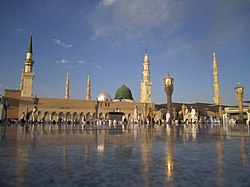| Safa and Marwa | |
|---|---|
Left: A sign guides pilgrims toward Safa Right: Path of movement between Safa and Marwa, illustrated alongside the Tawaf or circumambulation of the Ka'bah | |
| Highest point | |
| Parent peak | Safa: Abu Qubais Marwa: Qaiqan |
| Coordinates | 21°25′25″N39°49′38″E / 21.42361°N 39.82722°E |
| Naming | |
| Native name | |
| Geography | |
| Country | |
| Region | Hejaz |
| Province | Mecca |
| City | Mecca |
| Parent range | Hijaz Mountains |
Safa and Marwa (Arabic : ٱلصَّفَا وَٱلْمَرْوَة, romanized: Aṣ-Ṣafā wal-Marwah) are two small hills, connected to the larger Abu Qubais and Qaiqan mountains, respectively, [1] in Mecca, Saudi Arabia, now made part of Al-Masjid al-Haram . Muslims travel back and forth between them seven times in what is known as saʿī (Arabic : سَعِي, lit. 'seeking/searching or walking') [2] ritual pilgrimages of Ḥajj and Umrah .
Contents
- Geography
- History
- Geological perspective
- Islamic narrative
- Before Muhammad
- Revisionist and source critical views
- Significance in the Hajj and Umrah
- See also
- References
- External links
Muslims run between the two mountains, which they believe was made a ritual as a tribute to Hajar's search of water for her child dying of thirst until she found a water source in the Zamzam Well. The space between the two mountains in which the pilgrims run is called al-Mas'aa. [1] [3]

















